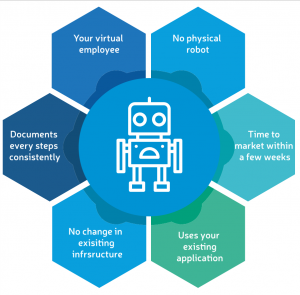What’s the Buzz About?
Process automation has been around for years. So what exactly is new about RPA? In the context of business processes, robots are virtual agents that mimic the actions of a human being when it comes to interacting with applications. Robots eliminate the need for certain types of low-skill roles. More importantly, they are incredible employees – working 24 hours a day, 365 days a year, and performing repetitive tasks rapidly and without a single error. They also cost a fraction of a typical Fulltime Equivalent (FTE) employee and can be put to work rapidly with limited input from the IT function.

Being Optimistic
While the buzz surrounding RPA is enormous, some believe it cannot make deep inroads into AP. They cite invoice inconsistency and imperfections in Optical Character Recognition (OCR) tools. Skeptics also mention high levels of non-PO invoices in some organizations and frequent discrepancies that require smart communication with vendors. They warn that poor coding across a large team of robots could create payment chaos in unpredictable ways that are not encountered with human workers. Also, finance and accounting are critical processes, which impinge on the financial and regulatory health of the organization.
The Solution
In JTPs view, the truth lies somewhere in between the two extremes. RPA is neither a magic potion nor an empty promise. It’s true that every circumstance and exception in a complex process cannot be coded into robotics software. However, the intersection of two important trends is rapidly turning robotics into a potent technology with material real-world impact.
In the first trend, the drive for process improvement in AP has led to increasingly standardize processes, often with sophisticated e-invoicing capabilities.
The second trend shows a larger wave of automation across business processes, which has resulted in several players rolling out robotic technologies that are well suited to AP.
Our Service offerings on RPA include:
- RPA consultancy services
- Build and implement RPA solutions for the contact center back office /IT/IMS service management space.
- Build and Implement Unified Desktop and automations in the front office operations.
- Provide operations support for the all types RPA solutions
- Any repeatable task or rule-based activity can be automated through RPA.
- It is easy to implement and takes lesser cycle time to implement.
- RoI can be achieved in less than a year.
- Repetitive and rules based
- Accesses structured data sets
- Process is documented and standardized in practice
- Three or more staff are hired to complete the process
- Data input is prone to human error
Typical Processed Managed By RPA:
Finance and Accounting
Invoice Processing, AP and AR, Reporting, Enhance Year End Close Process, Bank Reconciliation, Fixed Assets Analysis, Master Data Management, Vendor and Customer Account Creation.
Human Resource
- On-Boarding, LOA Management, Populating Employee Data into Multiple Systems, Performance Appraisal Management
Finance and Banking
- New Account Verification, Data Validation, Customer Account Management, Financial claims processing, Report Creation, Form Filling, Change of Address, Loan Application processing
Jersey Tech Partners Thoughts on RPA:
- The Bottom-line: RPA satisfaction is a lot higher when the motivation and mentality is one of process improvement, not cost-elimination
- The main issue with RPA, in today’s market, is this misconception that customers will make significant headcount reductions in the short-term.
- With outsourcing, the cost savings are staged carefully over a 5 year engagement as work is moved to cheaper locations, better technology and processes are introduced, in addition to automation, and the processes are re-mapped over time to allow for work to get done, ultimately with less people.
- Simply plumbing in RPA and not having a broader plan to transform the work, pulling several other value levers, in addition to the patching of processes and digitization of manual work, will likely result in a mismatch between expectations and reality.
- RPA needs to form part of a broader strategy to automate and streamline work, where people, processes, analytics tools, SaaS platforms, outsourcing models and carefully developed governance procedures, are taken into account as part of the broader transformation plan.
- Customers must take a more transformative view that if they can free up 50% of an employee’s time, they need to focus on refocusing her/him on alternative activities. That is where the value is to be found.
